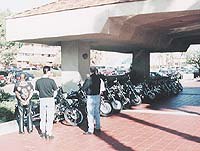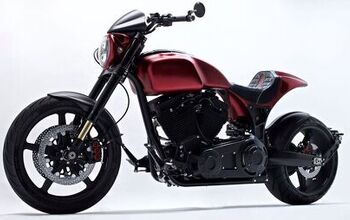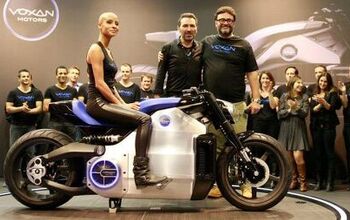Michelin Commander
LOS ANGELES, May 1998 -- It's funny how you can live your whole life someplace and ignore some of the coolest things in your backyard. I had heard of Idyllwild, close to Palm Springs, but it sounded like just another crummy desert town. Then, on one of this winter's five dry days, Michelin invited MO out to Palm Springs to sample their new Commander cruiser tire, and to take a ride to -- yep -- Idyllwild.
I arrived at Palm Springs after 700 miles on a Harley-Davidson Dyna Wide Glide, so I was able to draw a direct comparison between the ride of the stock Dunlop D204s and Michelin's new Commanders. But before letting the press loose on the beautiful, custom H-D's assembled in the parking lot, Michelin gave a small seminar on their new tire.
Michelin designed this tire in the United States. Over 400 "Big Twin" riders rode prototypes and competing tires, for a combined total of 500,000 miles, and provided feedback. Michelin found that the most important things to cruiser riders were, in order: durability, price, appearance, handling, grip, and wear pattern (no square tires). To achieve these goals they used rayon, aramid fibers, and a host of other exotic materials to put together what they call the "most advanced cruiser tire ever."
We can already hear the chorus of indignation arising from the squidly masses. "Isn't this a waste of time? Aren't cruisers supposed to handle like crap anyway? So what? Why not just put solid rubber rings around those high-polish, machined-aluminum wheels? It's not like anyone will be able to tell the difference."
How wrong you are, roadkill.
For the test ride, I managed to grab the only Dyna Wide Glide present, not only for the scientific comparison of apples to apples, but also because the rubber-mounted engine is nice on a long ride.
Heading out of town towards Interstate 10 there was no noticeable improvement over any other tire, but once on the freeway it became immediately apparent that the Commander was different. On the way to the intro on the same patched and worn-out stretch of asphalt and concrete, Interstate 10, the stock front tire on my Harley bounced on the expansion joints; and forget about resting your feet on the back pegs on long trips. On the stock Dunlop D402s, taking the weight of your legs off the front end causes massive de-stabilization.I thought that this was just a design flaw or a slice of the Wide Glide's character, but shod with the Commanders, the Dyna's front was much more stable, even with feet on the rear pegs. Michelin claimed their new carcass would absorb the shock of annoying lane markers and ignore rain grooves, and they were right. Riding directly down a row of lane markers was only slightly more uncomfortable than riding on the Dunlops down the number-one lane of the highway. A change of tires made this boulevard bully a sultan of the superslab.
State Road 273 (SR.273) South looked like yet another desert road, but soon it began an extreme ascent into the San Jacinto Mountains. Whoa. Why didn't anybody ever tell me about this road? I don't care what kind of bike you ride, this road rules. It's a long series of sweepers and switchbacks, mostly clean, even after being rained and snowed on. The soft-compound Commander tires stuck to the ground, handled well and didn't get out of shape. The Hogs at the head of the group were riding at a pace that would embarrass some sportbikers, dragging parts and having a blast doing it.
Once we reached the snowbound hamlet of Idyllwild, we stopped for a pleasant lunch at the Idyllwild Cafe. Here, having already done a toe-to-toe comparison against the stock rubber, I switched to a less conventional mount. For the trip down the mountain I chose a hybrid Fat Boy/Softail, either a Fat Boy without floorboards or a Softail with Fat Boy sheet metal and front end; either way this was one cool ride. Thinking I was going to have to take it easy on the way down was a mistake. Good rubber and improved ground clearance from a stock Fat Boy made going down the hill more fun than going up. The backside of the mountain is known as "Seven Layer Road," named after the tortilla dip. Seven Layer Road (SR.74) is named for the distinct environments you travel through on your way up or down. Unlike SR.243, which pops you unexpectedly into the snowbound reaches of the higher elevations, SR.74 takes a casual, bobbing route from the snow to temperate farmland, then down to the decadent health-spa commune of Palm Desert.
The few miles of the road would have been a blast as it wound down out of the mountains, but we got stuck behind some grandpa in a Lincoln that refused to use any of the turnouts. That's okay, there are ample places to pass when you get back to the desert floor.
After the Michelin ride, I bounced home to Los Angeles on the Dunlop-shod Wide Glide. The verdict: Michelin Commanders kick ass. The only real claim that Michelin made that we couldn't prove was that they wear as well as the hard-compound D402s. Yet, given their performance on the mountain, this claim seemed unlikely.
A month later we stopped in at Route 66 Riders, the motorcycle rental company that provided the bikes Michelin used at the intros. Many of their bikes were still shod with the Commanders left over form the intro, and we asked how they were holding up. The owner, raves about how plush the ride was on the Commanders, and questions about how much they were, and where they could be purchased.
Bartels seemed most impressed by the wear of the soft rubber. The Commander-equipped test bike with the most miles on it was a gray Heritage Softail that had racked up 2,600 miles. He said that to really be a contender for rental fleet service the Commander would have to last nearly the 11,000 miles that the Dunlop D402 rear will go before it has to be replaced. At a quarter of those miles, the Commander looked nicely scuffed in, but still looked fresh. A few months later, just before posting time, we called Bartels, who told us that the rear Commander tire looked to last about 8,000 miles under very hard use, while at that mileage the fronts still looked fresh.
Michelin has raised the cruiser-tire bar considerably. The new Commanders look cool, ride smooth, handle like radials, and look to last about as long as their OEM competition. But they are a little more expensive. The fronts run from $120-145 and the rears retail at about $170, but they make up for it in ride quality. Commanders are currently only made in sizes to fit Harley-Davidsons and clones, but sizes to fit other cruisers are coming. With no real faults and decent durability, we give the Michelin Commander four and one-half stars.
More by Billy Bartels, Associate Editor







































Comments
Join the conversation